The Art of Masonry Moisture Control: The Surgical Procedure of Masonry Repair
Be sure to check out Part 1: Considerations for Masonry Exteriors.
Testing Methods
The testing methods used to evaluate moisture intrusion are beyond the scope of this article and are even harder to explain to a client that is fed up with failed attempts and long-winded explanations. They just want to be told that the war is over. But to summarize, its typically a combination of two or more of the following methods:
1. Building Research
2. Infrared Imaging
3. Moisture Readings
4. Rilem Tube Testing
5. Controlled Water Testing
6. Destructive Testing/Material Removal
For reasons we can’t get into, there are a lot of opinions and resources about Destructive vs. Non-Destructive Testing methods and their validity, which I encourage the reader to explore at your leisure. There are few substitutes, however, for good old-fashioned scientific method: Theorize, Predict, Test, Analyze, Retest and Record. In our world, that approach is manifested in the form of inspection, testing, repair, and re-testing the repair with EXTENSIVE DOCUMENTATION throughout the entire process and a thorough report at the end of the project for the client in a usable format. But before you can convince the client to shell out the money for corrective action, you often must demonstrate for them and convince them why your solution will succeed where others have failed. We tailor this approach to the client whether its writing reports, compiling videos, cutting pictures and videos together to show specific pieces of information, power point presentations, or relayed in the form of external articles detailing similar issues.
Ultimately, you can think of it like this: Testing is designed to simulate or identify the effects of outside elemental forces when applied to the prolonged exposure of building vulnerabilities. Everyone involved in the project from the top down, client to contractor, needs to know how we got here and how to fix it. The approach needs to be clear and concise with documented evidence to support our conclusions. Those conclusions will then lead to design alterations and material selection best suited to the individual building, its climate zones, and intended use.
CASE STUDY #1: Cases of Urban Renewal
Two very specific projects come to mind here that have very similar but unique challenges to overcome but are also not unique to Nashville gentrification. Both cases involve the adaptation of existing solid brick masonry buildings by restoring the interior and exterior to be suitable for modern commercial application. In our world that usually means new doors and windows, the application of insulation and drywall, and the inclusion of computer-controlled HVAC systems to maintain set temperatures throughout the year. Here’s the problem that always comes up only after the project starts, the building was never designed for all this. Old brick buildings, in this case circa 1900, hate new fixtures, fenestrations and finishes. The mortar is falling out, the brick is 3 or more courses thick, the electric/grounding is non-existent, the rough openings struggle to accept new doors and windows with consistent sealant joints; and all the while, the building is trying to breathe while the renovation is trying to create an alternative atmosphere inside in a hot, humid climate zone in the southeast region near a major river. Insert expletive.
Barring every other challenge in achieving this herculean task, priority should be to keep the water out. This is for two reasons: One, you have no idea what you’ll run into on the exterior restoration until you start working on it, and there will always be unforeseen conditions to contend with. Two, you typically have a finite budget to work with, so you must put that toward protecting what’s inside the building working from the outside in, the other way around. The latter is often the chosen path in my experience and the least wise.
In the case of urban renewal with these two projects, both parties opted for exterior restoration but in very different ways. Let’s call them Building 1 and Building 2. Building 1 did it right. Building 2 did not. Both projects planned for significant restoration and remodeling. Building 1 put their money and planning on the outside. Building 2 clearly put their money and planning on the inside. For the sake of healthy debate, there’s only a couple of options to choose from at this point as an owner/decision maker deciding scope. You can either utilize over cladding or apply a topical solution. Both require significant amount of evaluation and planning. For clarity, both cases chose to pursue a topical solution. A topical solution can be defined as commercial grade sealants and waterproofing materials in liquid form that cure to form a protective coating on the building exterior that can both move and breathe in many cases.
In the interest of brevity, Building 1 opted for interior below grade negative side waterproofing (aka basement waterproofing) to address the unique drainage and access issues of rerouting water in a downtown space. Then they pressure washed the building exterior using walnut blasting to minimize brick damage. After, they tuck pointed every mortar joint and tooled the newly applied mortar. Finally, they pressure washed and brushed the repaired masonry to prepare the surface to accept final waterproofing application. Building 2 opted for an exterior waterproofing application that did not include blasting and tuckpointing repairs and failed to coat properly and evenly the exterior and all its facets. In fact, many of the preexisting structural features remained in place serving no other purpose than directing water into poorly sealed mortar joints with negative slope toward the walls. Imagine a giant piece of I-beam or angle iron mounted to an outside wall, tilted toward the building with holes in the exterior. It’s like having a gutter with no back flange pouring water into your house. Senseless. But the material is not to blame in the case of building 2. It is design and workmanship.
Exterior sealants are always a last resort recommendation in my opinion because it doesn’t address the immediate and greater areas of concern, it’s more of a Band-Aid approach. The most important part of any coating, as any manufacturer’s rep will tell you, is that the larger voids are filled with either a filler or permathane of some kind. In voids greater than 1/8”, there must be ample opportunity for adhesion to all sides of the void in question, hence the use of backer rod and permathane as a common application. There should be a of surface area with an hourglass shape which provides both adhesion and elongation without separating the bonds on either side of the void. When the applicator coated the masonry on building 2, he did not account for these voids and simply rolled or sprayed multiple coats over them. It would appear to be coated however, if voids are left open and/or moisture is present in the masonry itself, the waterproofing will fail and either the voids will fail, or the moisture will escape creating new ones in the applied waterproofing.
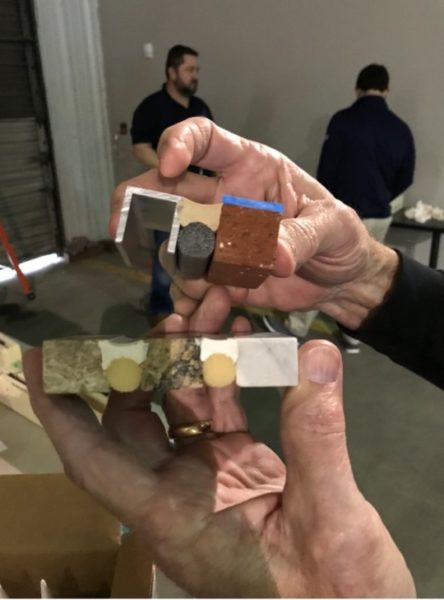
Examples of proper adhesion/sealant joint shape – notice the hourglass formation. This is for greater adhesion on outside surfaces while providing elongation for expansion and contraction at the middle.
Building 2 called for leak investigation yet building 1 remains dry. To demonstrate this to the customer on the Building 2 leak call, we employed controlled water testing and documented the rate of absorption with direct applied water to apparent voids, which recreated immediate leaks in the exact existing locations reported in all three leak locations we received. However, when this evidence was presented to the customer, they were not interested in the test results or understanding the concept, they were only interested in making the leak stop. Issuing caution, it can be difficult to explain why topical sealant applications won’t work in the long run but even harder to prove unless you’ve worked with the client in the past and demonstrated success where others failed. Our best hope is a compendium of case studies to use as a podium while stating our case for investigative measures.
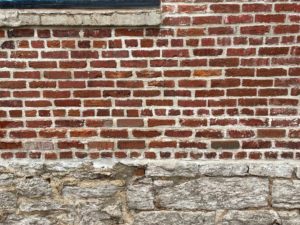
Building 1 exterior tuck pointing complete.
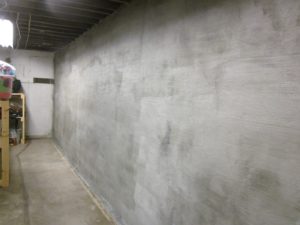
Building 1 interior view of completed waterproofing.
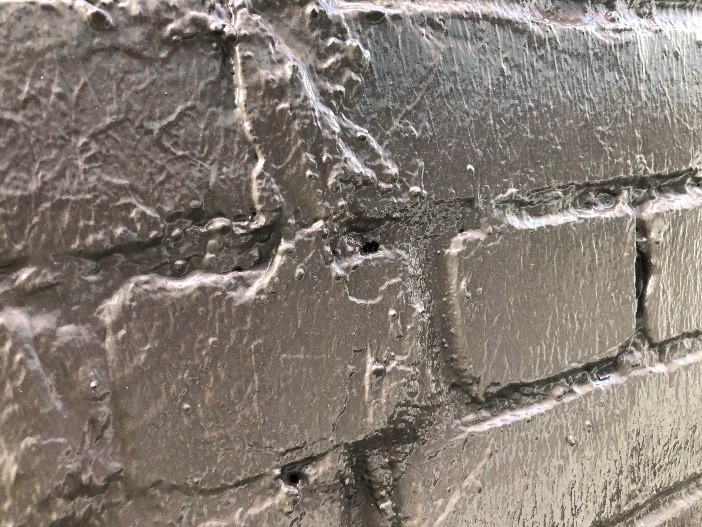
Building 2 typical exterior wall condition with completed yet inadequate sealant application.
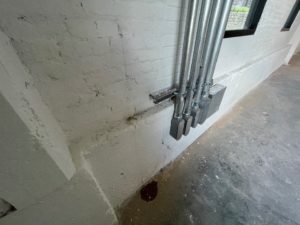
Building 2 interior moisture intrusion after completed exterior and interior sealant application when subjected to limited testing (approx. 1 min).
Scope of Work and Selecting the Contractor
Therefore, we investigate first, and test as needed. Our findings will determine scope of work with the greatest chance of success addressing as many known factors as possible. Many errors are easily avoided when given the proper attention to detail. But we can’t fix what we don’t know. If you go to the doctor for stomach pain, they won’t wheel in the operating table and remove your spleen without first ordering some tests. It’s good to retain a multitude of council and seek alternate opinions. Reporting and test results will help mediate those discussions with a bit of baseline information to be considered as a matter of permanent record.
The investigative testing and reporting will also serve as a blueprint for the overall scope of work so that all contractors involved will be bidding the project the same way. When a clear scope of work is put forth, contractors can ask questions and make suggestions that will serve the client first. The client will also receive similar bids so they can measure qualifications and presentation against the price of services rather than have an irritating array of wildly different bid prices and proposals, making it difficult if not impossible to choose the most suited contractor for the job.
It’s imperative that you choose the right contractor for the job. You must compile a group of proven contractors that you go to for other projects. A building enclosure specialist can help with this if you don’t already have contractors in mind or can add your preferred contractor to their own existing bid list. Just know that price should never be the sole determining factor in selecting the right contractor. Not every tool is suited for every job. You wouldn’t use a sledgehammer for a tack nail. Selection should be based on who has the most thoughtful proposal and most demonstrable success on similar projects in size and scope. Then, using a clear scope of work and bid requirements, you can quantify your selection process based on the best obtainable version of the facts and figures presented in a clear and comparable format. Again, ultimately saving you time and money so you can get on with the work at hand.
CONCLUSION
We reviewed a few critical facts at the beginning of this article that we should revisit.
1. Masonry leaks, contrary to popular belief
2. It has everything to do with workmanship and design, rarely is material to blame
3. Solving any envelope issue regarding masonry is likely going to cost money, spend it efficiently
4. Rely on trusted professionals with proven experience that will help you spend that money as efficiently as possible.
Its important to remember these points and sear them into memory for future reference as a reader because in times of crisis we all default to patterned behavior. Rarely is that patterned behavior conducive to efficient and productive outcomes in solving enclosure issues. When you’re faced with any of the masonry moisture intrusion challenges discussed in this article, you’ll want to do a couple of things right away: remove yourself from the equation and focus on what the building is saying. Enclosure specialists translate what the building is trying to say, and we make sure that whatever solutions are proposed have the greatest possible chance of success based on the information available. That means as the owner/decision maker, you must trust the process and seek a second opinion where required.
Also, be prepared for inevitable contingencies and unforeseen conditions – the beauty of this work is that every project is different. Mark Twain said, “History doesn’t repeat itself, but it rhymes.” Know that going in and prepare yourself for the unknown and trust your team to see it through to the end. Hopefully this article has armed you with some more advanced knowledge of masonry moisture intrusion. I would go so far as to consider it essential knowledge both professionally and in your personal life like changing a tire or starting a fire. It’s the kind of knowledge that will empower and serve you in times of crisis. But, should you find yourself in a position to need it without an awareness of its nuance, its already too late.








